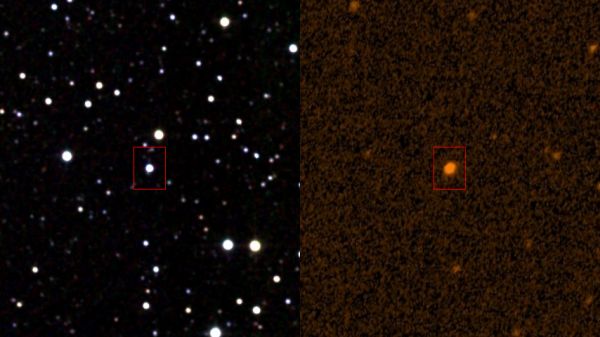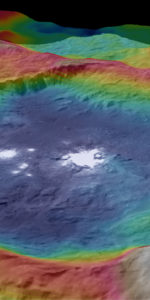
Not too long ago, KIC 8462852 represented just an obscure reference on astronomers’ star catalogues. With an age and mass slightly larger than that of the Sun, KIC 8462852, which is located approximately 1,480 light-years away in the direction of the constellation Cygnus, is just one of the many billions of F-type, main sequence yellow-white dwarf stars that populate the galaxy. Yet, as fate would have it, this inconspicuous star rose to fame unexpectedly about a month ago, after astronomers had detected a series of anomalous brightness fluctuations which have been widely attributed by members of the media and the public at large to be the potential workings of a highly advanced extraterrestrial civilisation. Following-up on the possibility that this might indeed be the case, the SETI Institute conducted a comprehensive search for any potential radio signals that could have been transmitted by such a civilisation in the vicinity of the KIC 8462852 star system. Nevertheless, and despite the fact that SETI scanned a wide range of frequencies, it has reported that no signals of potential artificial origin could be detected.
Even though the most probable explanation for KIC 8462852’s enigmatic dips in brightness according to astronomers is the presence of a vast belt of cometary objects around the star, or some other naturally occuring astrophysical process which has gone undetected to date, an alien super-civilisation still represents a credible alternative. This notion is based on the theoretical work on extraterrestrial intelligence that was pioneered by American physicist Freeman Dyson and his Russian counterpart Nikolai Kardashev during the 1960’s. While contemplating on the subject of communicating with an extraterrestrial civilisation with the use of radio signals, Kardashev devised a numerical system with which he categorised such civilisations based on the total amount of energy that they could master. On this numerical system, which later came to be known as the Kardashev Scale, a Type I civilisation is able to harness the energy output of an entire planet, a Type II civilisation can utilise the total energy of a single star and a Type III civilisation can master the total energy output of an entire galaxy. In comparison, our own civilisation which we self-centerly think of as being the apex of all creation, isn’t even on that scale at all – it’s just a lowly Type 0 civilisation which uses fossil fuel from underneath the Earth in order to satisfy its ever-increasing energy needs.

Based on a concept that was first described by the legendary British science fiction author Olaf Stapledon, Freeman Dyson hypothesized that a Type II civilisation would have the ability to construct gigantic megastructures around stars, with sizes on the order of the Earth’s orbit around the Sun, with which they could collect all of the star’s emitted energy for their power consumption purposes. Dyson theorised that such hypothetical alien megastructures, which eventually were named ‘Dyson spheres’ in his honor, would ultimately be visible across interstellar distances in a way similar to what has been observed around KIC 8462852. Following up on the possibility that the latter exhibited the signs of such alien astroengineering, the a research team from the SETI Institute implemented an observing campaign with the Allen Telescope Array which is located in San Francisco, Calif. in the hopes of intercepting any radio signals that could have been transmitted by such a Type II civilisation.
SETI’s observing strategy in the case of KIC 8462852 was two-fold. More specifically, the researchers conducted a thorough scan in the full range of frequencies from 0.5 to 11.2 Gigahertz, while looking for two types of radio signals: narrow-band ones of the order of 1 Hz in width and broad-band ones with a 100 kHz resolution. While narrow-band radio signals would be the transmission of choice for any civilisation that would deliberately want to ‘hail’ us, it was also assumed that if a Dyson sphere indeed enveloped KIC 8462852 it would need fleets of orbiting spacecraft with which to assemble and service it. These servicing spacecraft would exhibit their own excess radiation that could be detected as broad-band emissions in the microwave part of the spectrum. “Our searches are based on conceptually different scenarios for the putative alien transmitter,” write the researchers in a pre-print study summarising their results. “For the narrowband search, the archetypal transmitter is an intentional beacon directed toward the Earth with the specific goal of announcing an extraterrestrial presence. The second archetype is incidental radiation resulting from propulsion by powerful, beamed microwave transmitters. In this case, the suggestion is that if the matter occluding the star is actually due to extensive megastructures, then microwave-driven spacecraft to service these structures could inadvertently be revealed by a powerful, wide bandwidth signal.” Yet, after observing KIC 8462852 continuously for two weeks between October 15 and October 30, the SETI Institute announced that it had detected no signals that could possibly be artificial in nature. “We have made a radio reconnaissance of the star KIC 8462852 whose unusual light curves might possibly be due to planet-scale technology of an extraterrestrial civilization,” write the researchers. “The observations presented here indicate no evidence for persistent technology-related signals in the microwave frequency range 1 – 10 GHz with threshold sensitivities of 180– 300 jansky in a 1 Hz channel for signals with 0.01 – 100 Hz bandwidth, and 100 jansky in a 100 kHz channel from 0.1 – 100 Mhz.”

observations of quasar 3C84 (blue curve) and KIC 8462852 (black curve). The black points show the response curve when the telescope is pointed at KIC 8462852. The lack of any wideband emission from the star is evident. Image Credit: Harp et al (2015)
It should be noted as the study points out, that these numbers only represent the upper limits of threshold sensitivities and are equal to approximately 100 times the total energy output of our civilisation today in the case of the narrow-band signals and 10 million times for the broad-band ones. A radio signal from another extraterrestrial civilisation that would be specifically directed towards us might be less powerful. “These limits correspond to isotropic radio transmitter powers of 4 – 7 1015 W and 1020 W for the narrowband and moderate band observations,” the study concludes. “These can be compared with Earth’s strongest transmitters, including the Arecibo Observatory’s planetary radar (2 1013 W EIRP). “Clearly, the energy demands for a detectable signal from KIC 8462852 are far higher than this terrestrial example (largely as a consequence of the distance of this star). On the other hand, these energy requirements could be very substantially reduced if the emissions were beamed in our direction…This report represents a first survey placing upper limits on anomalous flux from KIC 8462852. We expect that this star will be the object of additional observations for years to come”.
It could be argued that SETI’s assumptions regarding the star KIC 8462852 were ultimately flawed. Provided that an alien super-civilisation indeed inhabits the star system, it wouldn’t be unreasonable to assume that it would use other means instead of radio waves for communicating across vast interstellar distances, means that we might not be able to detect or even imagine in the first place. A past AmericaSpace article examined these limits of human perception and of our preconceived notions in acknowledging things that lie beyond our current understanding, similar to the way that an isolated tribe on a remote island is only aware of the drum as a means of communication but is ultimately oblivious to all the man-made radio waves that propagate in the skies above it. Nevertheless, one has to start from somewhere and given the current level of our technology and our understanding of the Universe, it could be argued that SETI’s approach is justified.
Meanwhile, the lesson that everyone can take out of all this, is one of caution. “The history of astronomy tells us that every time we thought we had found a phenomenon due to the activities of extraterrestrials, we were wrong,” comments Seth Shostak, Senior Scientist at the SETI Institute. “But although it’s quite likely that this star’s strange behavior is due to nature, not aliens, it’s only prudent to check such things out.”
In the end, this mixture of guarded optimism and skepticism might be our best hope for ever uncovering some of the greatest mysteries the Universe has to offer.
Be sure to “Like” AmericaSpace on Facebook and follow us on Twitter: @AmericaSpace
.






Interesting article, full of tantalizing possibilities. Let’s remember that 1,500 light years represent a mere 1.5% of the total diameter of our own galaxy! “They” are out there somewhere, but it will be the discovery of microbial life forms first before any “intelligent” beings are found.